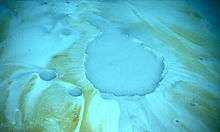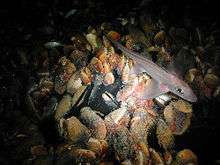Brine pool



A brine pool is a large area of brine on the ocean basin. These pools are bodies of water that have a salinity three to eight times greater than the surrounding ocean. For deep-sea brine pools, the source of the salt is the dissolution of large salt deposits through salt tectonics. The brine often contains high concentrations of methane, providing energy to chemosynthetic animals that live near the pool. These creatures are often extremophiles.[1][2] Brine pools are also known to exist on the Antarctic Shelf where the source of brine is salt excluded during formation of sea ice. Deep-sea and Antarctic brine pools can be toxic to marine animals.
Characteristics
Brine pools are sometimes called sea floor "lakes" because the dense brine does not easily mix with overlying seawater. The high salinity raises the density of the brine, which creates a distinct surface and shoreline for the pool.[3] When submarines dive into brine pools, they float on the brine surface due to the high density. The motion of a submarine can create waves across the brine-seawater interface that wash over the surrounding "shoreline".[4]
Support of life
Deep sea brine pools often coincide with cold seep activity. Methane released by the seep is processed by bacteria, which have a symbiotic relationship with seep mussels living at the edge of the pool. This ecosystem is dependent on chemical energy, and relative to almost all other life on Earth, has little dependence on energy from the Sun.[5]
Role in Environmental Remediation
Inland endorheic basins are drainage basins without an outlet to the sea. Often, they have salt lakes or salt seas, which can evaporate. This can lead to problems with dust, which can be toxic as salt seas often absorb heavy metals and minerals including selenium, which can be poisonous if allowed to accumulate to toxic levels. Environmental change over time can also endanger wildlife dependent on an inland lake or sea. Although environmental change is a natural process, human activity can accelerate or alter the pace of natural environmental change; furthermore, many societies and communities have preferred to take a conservationist approach to the active management of natural resources. To mitigate or avoid environmental impacts of evaporating salt lakes - whether induced through natural or artificial processes, some restoration and conservation efforts have involved the creation of artificial brine sinks or brine pools.
One such effort has been proposed for the conservation of the Salton Sea in California. The method involves artificial earthworks and drainage structures to separate a body of water into a highly concentrated brine pool and a much less saline zone. Although this delays a body of water becoming entirely inhospitable to wildlife that cannot tolerate high levels of salinity, it does not remove dissolved salts and minerals from the local environment.[6]
Examples
References
- ↑ Extremophile life near brine pools Archived November 10, 2006, at the Wayback Machine.
- ↑ Eder, W; Jahnke, LL; Schmidt, M; Huber, R (July 2001). "Microbial diversity of the brine-seawater interface of the Kebrit Deep, Red Sea, studied via 16S rRNA gene sequences and cultivation methods". Appl. Environ. Microbiol. 67: 3077–85. doi:10.1128/AEM.67.7.3077-3085.2001. PMC 92984. PMID 11425725.
- ↑ NOAA exploration of a brine pool
- ↑ "The Deep" (2006), Documentary, National Geographic Channel
- ↑ World Wildlife Fund. "Deep sea ecology: hydrothermal vents and cold seeps." March 23, 2006. Accessed October 3, 2007.
- ↑ Hill, Elizabeth. "Restoring the Salton Sea" (PDF).
